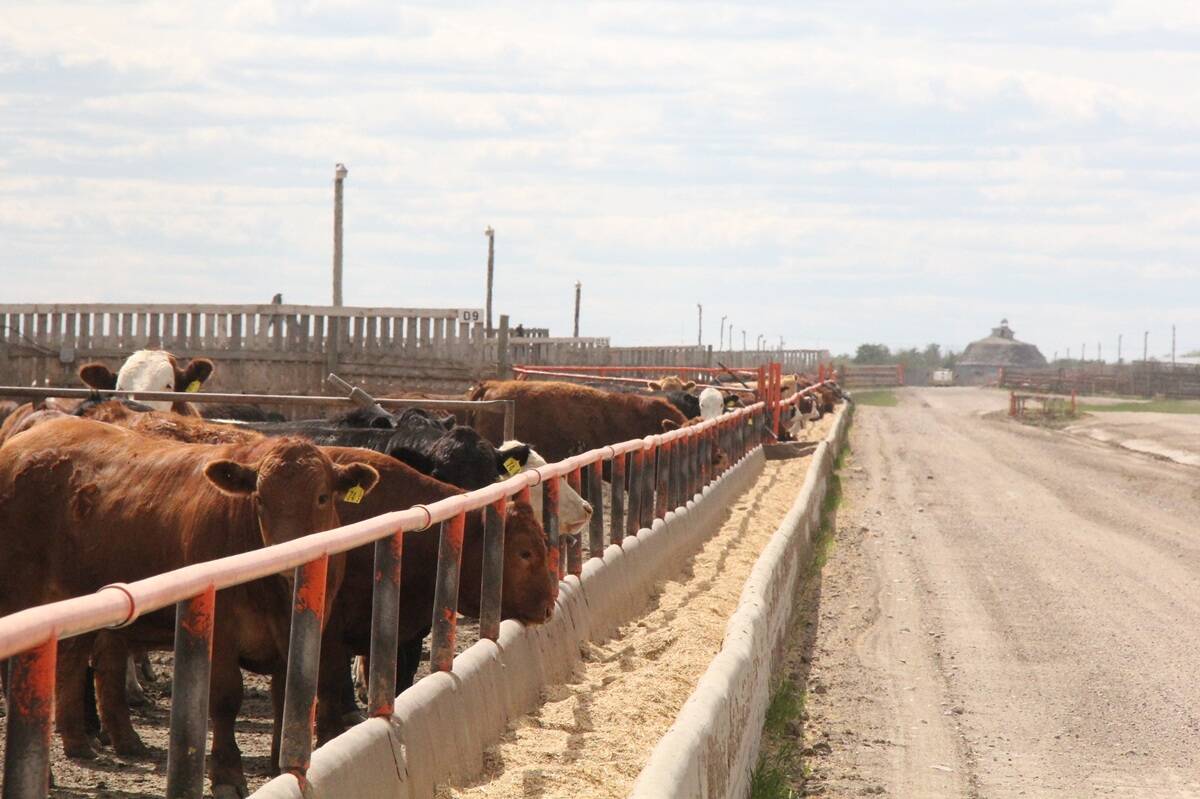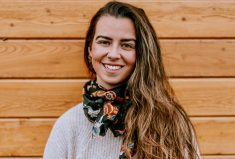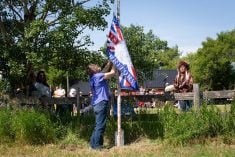Anthony Johnston dreams of Indigenous people returning to agriculture on Indigenous lands.
He remembers a time when family farms were a part of Indigenous communities. He reflects on how the buffalo were key to of a way of life for his ancestors on the Prairies. Standing at the front of the room at the International Federation of Agricultural Journalists annual congress in Olds, Alta., he wears that history, in the form of a sweater decorated with buffalo.
“The Plains bison, or the buffalo, are a Living Lab unto themselves,” says Johnston, special projects researcher with the University of Saskatchewan and knowledge keeper with Mistawasis Nêhiyawak, west of Prince Albert, Sask.
Read Also

Unwinding the fibre in feedlot cattle diets
Research into how barley rolling method and undigestible NDF levels affect animal performance and digestive health in finishing diets
His work with the Bridge to Land Water Sky Living Lab in north-central Saskatchewan is bringing Indigenous knowledge to the agriculture community. This is highlighted by the name Johnston developed for the Living Lab. Bridge to Land Water Sky means a link between a productive future with land (agriculture), water and sky (carbon sequestration and greenhouse gas reduction).
Bridge to Land Water Sky is the first and only Indigenous-led Living Lab.
Johnston is semi-retired after spending many years working for his nation but continues to pour his time into Bridge to Land Water Sky.
Indigenous farming
Johnston says when the Indigenous peoples of Mistawasis Nêhiyawak and Muskeg Lake Cree Nation entered Treaty Six when it was signed in 1876, their attention pivoted to agriculture.
“We couldn’t follow the buffalo anymore, because they almost became extinct,” Johnston says. “So, when we entered into Treaty Number Six, we saw agriculture as the new way to provide for the people, to feed the people.”
He says families had cattle, pigs, chickens and other livestock, and most households grew their own gardens.
However, the government created the permit system, which was in place until the 1950s and didn’t get removed from the Indian Act until 1995. The permit system restricted Indigenous people’s movement, and regulated the sale of goods off-reserve. According to the Canadian Encyclopedia, the pass system, coupled with a government policy that favoured settler farmers over Indigenous farmers, stifled agriculture on the reserves and crippled their economy.
“In some ways, we were sort of discouraged away from agriculture,” Johnston says.
Now, with Bridge to Land Water Sky being Indigenous-led, Indigenous knowledge has the opportunity to contribute to agriculture.
Currently, most of the land on Mistawasis Nêhiyawak Cree Nation and Muskeg Lake is leased to non-Indigenous producers.
“We still have a handful of individuals in each First Nation that grow grain crops, and on Mistawasis we have a couple of people who have small herds of cattle. So we still have some agriculture by our community members. But we’re looking for ways to return to being producers once again, and hopefully, our Living Lab will help.”
Bridge to Land Water Sky is a collaboration between Mistawasis Nêhiyawak, Muskeg Lake Cree Nation, Saskatchewan Aboriginal Land Technicians, North Saskatchewan River Basin Council, Redberry Lake Biosphere Region, the University of Saskatchewan, and Agriculture and Agri-Food Canada.
Bridge to Land Water Sky
According to a webinar done with the University of Manitoba in March of 2023, Bridge to Land Water Sky has six objectives:
- Engagement and relationship-building with farmers, youth and stakeholders
- Taking inventory of and mapping agricultural lands on the reserves
- Using “bundles” of best management practices to enhance cropland
- Restoring marginal lands “to regenerate grasslands and grazing land and forest”
- The collection of biophysical and socio-economic data
- Training, demonstration and education
Katherine Finn is the Bridge to Land Water Sky project manager. She joined the team at the suggestion of Johnston, whom she had worked with at her previous job at the North Saskatchewan River Basin Council.
Now, as project manager of Bridge to Land Water Sky, she’s involved with most of the things that go on at the Living Lab.
Finn says research is focused on both the crop and cattle side. However, because a lot of the land on Mistawasis and Muskeg Lake is marginal land, the research is better suited to livestock. For example, they’re looking at ways to regenerate fallow land.
“Likewise, to enhance marginal areas, to do a better job of sequestering carbon and then looking at other (best management practice) bundles in cropping management or integrating livestock grazing within those lands that’ll better sequester carbon.”
Those involved with the Living Lab are working alongside University of Saskatchewan researchers on the project.
Land-based knowledge
According to the Bridge to Land Water Sky website, one of the Living Lab’s goals is to “celebrate Indigenous knowledge as a key factor in building a more innovative and climate-resilient agricultural industry that will have global impacts.”
When it comes to taking care of the land and the environment, the seventh-generation principle, a Haudenosaunee philosophy, is well known, and means that decisions made now should result in a sustainable world for people seven generations in the future.
Johnston says this knowledge of the land can support the lab’s environmental goal.
“In the late 1800s, early 1900s, our ancestors were very successful producers, very successful farmers. And I think part of the reason for that is the intimate relationship with all aspects of the landscape. And that’s what perhaps we bring to the table. Despite it being the 21st century, we are still looking for ways to re-establish or revive that ancient respect and relationship with land, water, sky.”
To Finn, that intimate knowledge of the land is vital to the work done in the lab. She sees some common ground between Indigenous teachings and how some farm families see the land.
“I’d really want to emphasize the importance of that local knowledge and that expertise, and that ties back into the Indigenous perspective, traditional knowledge. You don’t have to be Indigenous to have traditional knowledge. If you’ve lived on the land your whole life and you’ve been generational farmers, you have a knowing that other people don’t have … so I really want to emphasize the value of that and the importance in guiding projects like ours.”
Community
After years of Indigenous communities no longer being closely associated with agriculture, Johnston says it’s important for the nearby communities of Mistawasis and Muskeg Lake to have a role in this Living Lab.
“That is important for us as Plains people, Nêhiyawak people of the Plains. In the time of my ancestors, when (they followed) buffalo, because we live in such a harsh climate, in order to survive there was a need to have an intimate knowledge, intimate relationship, with all aspects of the landscape,” Johnston says.
Because of this close relationship with the land, he says reclaiming agriculture is important for Indigenous peoples. Most of the agricultural land is leased to non-Indigenous producers, and while there are a few farmers from the communities, Johnston says he’d like to see more people start farming.
“It might be a way for us to include our young people to find ways to return to becoming farmers, producers, ranchers, once again on Muskeg Lake and Mistawasis,” Johnston says.
“We’re looking for ways to return to being producers once again, and hopefully, our Living Lab will help.”
Finn says a major part of her job is maintaining a good relationship with both Muskeg Lake Cree Nation and Mistawasis Nêhiyawak while working on the Living Lab.
“It’s not just about business interactions, but having that meaningful engagement and that sincere desire to want to know one another, to want to help one another … and I think that’s been fundamental in how we developed our Living Lab.”
Future
Now well into the second year of the Living Lab, there are three years left of research from what had been allotted by the federal government.
Finn says there have been administrative delays, so they are not exactly where they want to be, but for now, she says she wants to create agreements on what makes sense for the different best management practice trials and have those reflected in the lease agreements.
Finn says they also hope to find sustainable practices that work for producers who are leasing lands from the communities.
“There’s the hope or desire that if we can find sustainable practices that suit them that can be modeled to other producers because a lot of people watch what they’re doing and the hope is they would follow their lead to see what can work,” Finn says.
In Prince Albert National Park, Mistawasis Nêhiyawak has been involved with a program known as Buffalo Trace, to restore the buffalo to their natural habitat. Johnston says he hopes there’s an opportunity for Bridge to Land Water Sky to work with this program in the future.
He says this work all comes back to the future of the land for upcoming generations.
“We still have hope of returning buffalo to our lands. That could be two years from now, it could be five years from now. But in the very near future, we have thoughts of eventually bringing the two initiatives together…. Because they both have similar goals. And it’s looking for ways to reimagine agriculture, to ensure that we have healthy soil for the future and for future generations.”

















